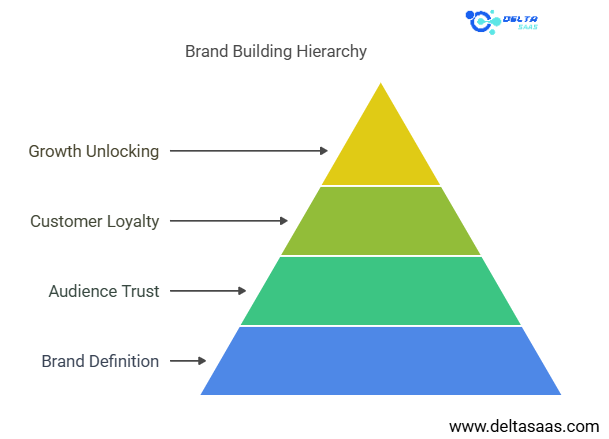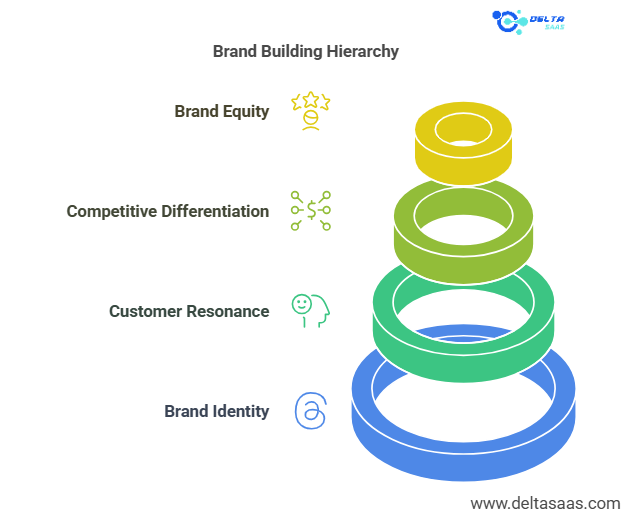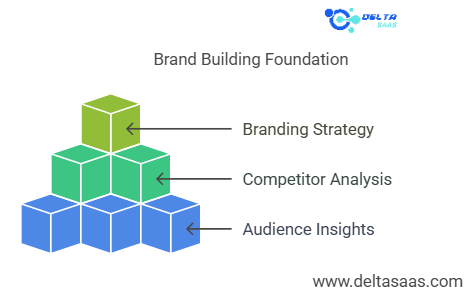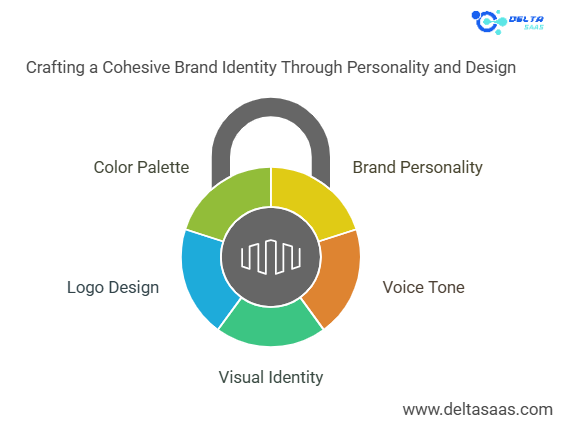
Brand Building Strategies: A Comprehensive Guide
Building a strong brand is essential for long-term success in today’s competitive market. A well-defined brand sets your business apart, creates trust with your audience, and drives loyalty. Whether starting a new business, managing a multi-brand portfolio, or strengthening your brand, understanding brand-building strategies is key to unlocking growth.
This blog will explain actionable steps for developing your brand, building authority, and creating a lasting connection with your audience.

What Is a Brand Building Strategy?
A brand-building strategy is a structured approach to creating and managing your brand’s identity, personality, and reputation. It includes defining how your brand communicates, resonates with customers, and stands out from competitors.
Brand building isn’t just about designing a logo or choosing colors—it’s about shaping perceptions and delivering a consistent experience. Strong branding builds brand equity, the value your brand holds in the minds of consumers.
If you’re looking for the best software, check out Delta SaaS, which offers discounts and lifetime deals on SaaS products.

Research: The Foundation of Brand Building
Thorough research is essential before building a brand. Knowing your audience, competitors, and industry trends will guide every decision in the branding process.
Research Your Target Audience
Understanding your audience is the first step in crafting a brand that resonates. Define:
- Demographics: Age, gender, income, location.
- Psychographics: Values, interests, and lifestyles.
- Pain Points: What challenges do they face, and how can your brand solve them?
For example, a brand targeting eco-conscious millennials should emphasize sustainability and transparency in its messaging.
Competitor Analysis
Analyze your competitors to identify gaps in the market and uncover opportunities. Look at:
- Their brand positioning.
- Visual identity (logos, colors, and website design).
- Messaging and tone of voice.
- Online presence and advertising strategies.
Use this research to differentiate your brand and avoid blending in with competitors.
Also Read,
Slay School Reviews – User Insights & Course Features
Socrates Reviews – Features & User Feedback
SparkReceipt Reviews: Is It Worth the Investment?
Triplo AI Reviews: User Feedback & Features
UPDF Reviews: Features, Usability, and Insights
Wiz Write Reviews: Insights on Features & Value
Xtensio Reviews: Best Tool for Business Document Creation
Crafting Your Brand Identity
Define Your Brand Purpose and Vision
Your brand purpose answers why your business exists, while your vision outlines the future you want to create. Together, they provide clarity and direction.
- Brand Purpose Example: A coffee brand’s purpose might be “to bring people together over ethically sourced coffee.”
- Brand Vision Example: “To become the leading provider of sustainable coffee globally.”
These statements inform everything from your marketing efforts to your internal decision-making processes.

Build Your Brand Personality and Voice
Your brand’s personality shapes how it communicates and interacts with the audience. Ask yourself:
- Is your brand fun and playful or professional and serious?
- What tone of voice will you use—casual or formal?
Your personality should align with your audience’s preferences. For instance, a fashion brand targeting Gen Z might use a trendy, conversational tone on social media.
Design Your Visual Identity
Your visual identity is how your brand appears to the world. It includes:
- Logo: A recognizable design that represents your brand.
- Colors: Choose a color palette that reflects your brand’s emotions and values.
- Typography: Use fonts that match your brand’s personality.
- Imagery: High-quality visuals that align with your story and target audience.
Consistency is key here—use the same design elements across all platforms to build recognition.
Brand Positioning: Carving Out Your Place in the Market
Brand positioning is how your brand is perceived in comparison to competitors. To position your brand effectively, identify:
- Unique Selling Proposition (USP): What makes your brand different and better?
- Target Audience: Who will benefit most from your product or service?
- Market Gaps: Where can your brand deliver value that competitors can’t?
For example, if you’re launching a new skincare line, you might position your brand as “natural, cruelty-free, and affordable.” This differentiates it from luxury skincare brands or mass-market products.
Building Brand Awareness
Use Social Media to Socialize Your Brand
Social media platforms are powerful tools for increasing brand awareness and engaging your audience.
- Share valuable, relatable content.
- Engage in conversations by responding to comments and messages.
- Partner with influencers who align with your brand values.
For example, a food brand can create viral content on Instagram by sharing recipes using its products.
Develop Your Website and Online Presence
Your website is a central hub for your brand’s online presence. To build credibility:
- Design a user-friendly, mobile-optimized website.
- Include an “About Us” page that tells your brand story.
- Showcase testimonials and case studies to build trust.
Additionally, ensure your site is optimized for SEO to boost visibility in search engines.
Building Brand Authority and Consistency
Building brand authority means establishing trust and credibility in your industry. This long-term effort involves delivering value and consistently meeting customer expectations.
Strategies to Build Brand Authority
Create High-Quality Content
Content is the cornerstone of establishing authority. Use a content marketing strategy to educate, inform, or entertain your audience. Examples include:
-
- Blog posts answering frequently asked questions.
- Videos demonstrating how to use your product.
- Infographics that simplify complex topics.
For instance, a fitness brand could publish free workout plans and nutrition guides to establish expertise.
Read More: Strong Building Customer Relationships for Success
Collaborate With Influencers
Partnering with trusted influencers can enhance your brand’s credibility. Choose influencers whose audience aligns with your target customers. For example, a multi-brand retail store can collaborate with fashion influencers to promote new product lines.
Use Customer Testimonials and Reviews
Positive customer feedback is one of the most potent tools for building authority. Add testimonials, case studies, and ratings to your website or social media pages.
Leverage Thought Leadership
Position your brand as an expert in your field by:
-
- Hosting webinars.
- Publishing white papers or industry reports.
- Speaking at industry events.
Your brand builds trust and authority by becoming a go-to resource for valuable information.
Maintain Consistency Across Channels
Consistency is critical in branding. It ensures that customers recognize and trust your brand across every touchpoint.
Tips for Consistent Branding:
- Develop Brand Guidelines: Document your brand’s logo usage, colors, fonts, and tone of voice.
- Align Messaging: Ensure your tagline, marketing campaigns, and social media posts reinforce the same message.
- Build Relationships: Consistent, personalized interactions help develop long-term loyalty.
For example, Coca-Cola’s branding remains consistent globally, from its logo to its messaging of happiness and togetherness.
Read more: Tips for Boosting Online Sales Effectively
Creating a Roadmap for Long-term Brand Success
A successful brand is built over time with a clear roadmap for growth. This roadmap should outline your goals, strategies, and action steps.
Steps in the Brand Building Process
Define Key Objectives
Ask yourself: What do you want to achieve? This could include:
-
- Increasing brand awareness.
- Building customer loyalty.
- Expanding into new markets.
Develop a Strategy Framework
Create a step-by-step plan to achieve your objectives. A strategy framework might include:
-
- Identifying your target audience.
- Developing your visual identity.
- Launching advertising campaigns to reach new customers.
Implement and Monitor Your Plan
Put your plan into action, but remain flexible. Use analytics tools to monitor performance and make adjustments.
- Track Metrics: Brand awareness, website traffic, social media engagement, and sales growth are key indicators of success.
- Evaluate Customer Feedback: Use surveys, reviews, and social media comments to understand how your brand is perceived.
Reevaluate and Adjust
Brands evolve. Revisit your brand positioning and messaging periodically to stay relevant.
Read more: Best Ways to Increase Traffic to Your Website with Proven Methods
Brand Storytelling: Connecting Emotionally With Customers
A compelling brand story allows your audience to connect with you more deeply. Your story should highlight your mission, challenges, and how you bring value to your customers.
How to Craft a Great Brand Story:
- Be Authentic: Share real stories about your brand’s journey.
- Focus on Emotion: Make your audience feel something—whether it’s excitement, inspiration, or trust.
- Highlight Impact: Show how your brand makes a difference in customers’ lives.
For example, TOMS Shoes built its brand around the story of giving back: for every pair of shoes sold, they donate a pair to someone in need.
Differentiation Branding: Standing Out in a Crowded Market
In competitive industries, standing out is critical. Differentiation branding focuses on highlighting what makes your brand unique.
Key Ways to Differentiate Your Brand:
- Offer a Unique Experience: Create an experience that customers won’t find elsewhere. For instance, a luxury hotel might emphasize personalized service.
- Focus on Quality: Deliver superior products or services to build customer loyalty.
- Innovate: Continuously improve your offerings to stay ahead of the competition.
Building an Online Presence
An online presence is essential for growing your brand in the digital age. Every digital touchpoint, from social media to your website, affects how customers perceive your brand.
Optimize Your Website
Your website should reflect your brand’s identity and make it easy for customers to interact with you. Ensure:
- Clear Navigation: Customers can find information quickly.
- Mobile Optimization: Your site performs well on all devices.
- Fast Loading Speeds: Slow sites can frustrate visitors and drive them away.
Social Media: Be Social and Engaging
Social media allows brands to reach their audience directly and build relationships. Choose platforms that align with your target audience.
- Instagram: Ideal for visual storytelling and influencer collaborations.
- LinkedIn: Great for B2B branding and professional thought leadership.
- Facebook: Effective for community-building and advertising campaigns.
Tips for Social Media Success:
- Post consistently using a content calendar.
- Engage with followers by responding to comments and messages.
- Use video content like live streams or short reels to boost engagement.
For example, a local coffee shop might post daily specials on Instagram Stories and engage with followers’ responses.
Effective Advertising and Promotion Strategies
Advertising is a crucial element in brand-building strategies. It increases brand awareness and reinforces brand identity. Effective advertising ensures that a message reaches the right audience for both small and large brands at the right time.
Key Advertising Tactics
Targeted Marketing Strategies
Advertising becomes more impactful when it’s targeted. Identify your target audience and customize ads based on their demographics, interests, and online behaviors.
- Use Google Ads for keyword-based search targeting.
- Leverage social media ads for precise targeting by age, location, or interests.
For example, a fitness brand can run Facebook ads targeting health-conscious users aged 18–35.
Storytelling in Advertising
Consumers resonate with stories that evoke emotions. Incorporate storytelling into your advertising to build a deeper connection with your audience.
- Focus on the “why” behind your brand rather than just the product.
- Use video ads to narrate your brand’s purpose visually.
For instance, Nike’s “Just Do It” campaigns focus on perseverance and empowerment, appealing emotionally to their audience.
Read More: How to Improve Conversion Rate in Email Campaigns
Incorporate Samples or Free Trials
Allowing customers to try your product before purchasing can increase trust and conversions.
- Offer free samples for new product lines.
- Provide free trials for software or digital tools.
Use Multi-Channel Advertising
Don’t rely on one platform—spread your campaigns across multiple channels, including:
- Social media platforms like Instagram and TikTok.
- Email marketing to re-engage existing customers.
- Offline channels like billboards or print media (if relevant).
Building Personal Brand Identity
Personal branding is an essential strategy for entrepreneurs, influencers, and thought leaders. It involves promoting your identity and expertise to build trust and influence.
How to Build a Strong Personal Brand
Define Your Brand Purpose
Determine what you want to be known for and how you want to help others. For example, a digital marketing consultant might position themselves as an expert in small business growth strategies.
Showcase Your Skills Online
- Use platforms like LinkedIn to publish articles and connect with industry peers.
- Share knowledge and tips on social media to position yourself as a thought leader.
Develop Consistent Messaging
Your brand should align with your values, expertise, and goals. Ensure consistency in tone, content, and visuals across your website, social media, and professional profiles.
Engage Authentically
Interact with your audience, reply to comments, and build meaningful relationships. Authenticity is key to building trust.
Read More: How to Increase Click-Through Rate in Email Marketing: A Complete Guide
Brand Equity: The Long-Term Goal
Brand equity refers to the value a brand holds in customers’ minds. Positive brand equity leads to higher customer loyalty, better pricing power, and stronger market positioning.
Strategies to Build Brand Equity
Deliver Consistent Quality
Customers should always expect the same level of quality whether they buy your product or interact with your customer service team.
Focus on Customer Experience Optimization
Provide a seamless and enjoyable experience across all touchpoints:
- Ensure smooth website navigation.
- Offer excellent customer service, both online and offline.
Build Emotional Connections
Brands with strong emotional connections often enjoy better loyalty. Apple, for example, connects with its audience through innovative designs and a sense of exclusivity.
Reward Loyal Customers
Create loyalty programs that reward repeat customers. Exclusive discounts, early product access, or personalized gifts can help foster long-term relationships.
Read More: Why Is Email Marketing Ineffective? Common Issues
Online Brand Building: Strategies for Digital Success
A strong online presence is vital for any brand in today’s digital era. The internet allows businesses to reach a global audience, but competition is fierce. Effective online brand-building strategies ensure your brand stands out.
Digital Strategies for Building a Strong Brand
Content Marketing Strategy
Create high-quality content that adds value to your audience. Use various formats, including:
- Blogs to address common customer queries.
- Videos to engage your audience visually.
- Social media posts, for short, shareable insights.
Consistency in publishing and focusing on SEO ensures your content reaches your target audience.
Build Relationships Through Social Media
Social media platforms are great for building relationships with your audience.
- Be responsive to comments and direct messages.
- Host live Q&A sessions to engage with your followers.
- Share user-generated content to foster community trust.
Develop Your Brand Elements
Your brand elements (logo, color scheme, and tagline) should be prominent across platforms, from your website to your social media profiles.
Utilize Email Marketing
Email campaigns can nurture leads and re-engage customers. Share personalized offers, product updates, and exclusive content through email.
Read more: Automated Email Marketing: Boost Campaign Success
Reevaluate and Adjust Your Brand
Brand building is an ongoing process. Periodically reassess your branding strategies to ensure they remainpractical and effective.
Signs It’s Time to Reevaluate Your Brand:
- Customer needs or preferences have shifted.
- A new competitor is disrupting your market.
- Your current branding feels outdated.
For instance, after conducting market research, you may realize your brand identity needs a modern refresh to appeal to younger audiences.
Conclusion
Building a strong brand requires careful planning, consistent execution, and deep understanding of audience. By focusing on research, brand identity, online presence, and long-term strategies like content marketing and customer engagement, you can establish a brand that stands out and earns trust.
Remember, the brand-building process is ongoing—keep reevaluating, adjusting, and growing to stay relevant and successful in a dynamic market. Start small, stay consistent, and let your brand’s value shine through every interaction.
FAQs on Brand Building Strategies
What is a brand-building strategy?
A brand-building strategy is a structured plan for creating, developing, and growing a brand’s identity, reputation, and audience.
What are the four types of branding strategies?
The four types include corporate branding, personal branding, product branding, and service branding.
What are the four steps in building a brand strategy?
The steps are:
- Define your brand purpose and identity.
- Research your audience and competitors.
- Develop your visual and verbal identity.
- Execute and monitor your branding efforts.
How can I create a personal brand identity?
Start by defining your unique strengths, showcasing your expertise online, and maintaining consistent messaging across platforms.
What is brand equity?
Brand equity refers to the value your brand holds in customers’ minds based on their experiences and perceptions.
What are examples of effective brand-building strategies?
Examples include:
- Partnering with influencers.
- Consistently creating valuable content.
- Using social media to engage your audience.
How can I measure the success of my branding efforts?
Track metrics like brand awareness, customer loyalty, website traffic, and social media engagement.
What is differentiation branding?
Differentiation branding emphasizes unique features or benefits that set your brand apart from competitors.
Why is storytelling important in branding?
Storytelling creates emotional connections with your audience, making your brand more relatable and memorable.
How do you build an online presence for your brand?
Optimize your website, create valuable content, engage on social media, and use email marketing to connect with your audience.


